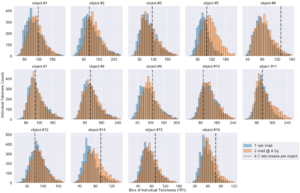
Jared Luxton is in the Cell and Molecular Biology 2016 cohort doing research on telomeres out of the Bailey lab. Both an active member of the CMBSA and an accomplished computational biologist, Jared has proved himself to be a competent and welcome addition to the CMB family.
Tell a bit about your life before you joined CSU
I’m originally from Massachusetts! Prior to CSU I was living and working as an Extraction Chemist in a small Massachusetts town. The job was on 3rd shift, so I’d wake up around 8:00pm and get home around 8:00am. Typically I’d drink an entire pot of coffee before work, and once I was there I’d put another pot on ASAP.
Tell us about your research project and what attracted you to your area of interest
Everybody has a personal experience with cancer or knows someone who does; this is where my interest in telomeres started. Telomeres are fantastic structures of DNA/RNA/proteins at the ends of linear chromosomes, and sit at many intersections between cancer, disease, and health. Telomeres shorten with cellular division, serving as a pseudo-mitotic clock for cells, and as such, almost all cancers must address telomere maintenance to facilitate growth. Not only do telomeres shorten after cellular division, but they also shorten in response to environmental stressors, i.e space radiation. Astronauts in space are chronically exposed to space radiation, and how that impacts health, mission performance, and long-term health outcomes remains an open and important question for safety during space travel. A large part of my research addresses the impacts of space radiation on astronaut health in the context of telomeres.
What do you do to relax when you’re not in the lab?
Lately I’m ‘relaxing’ by learning new concepts in the programming language python. I’m also an enthusiast for Netflix/Hulu/Youtube! Dark is one of my favorite Netflix series (way better than Stranger Things).
What is your favorite thing about the CMB program/CSU/Fort Collins?
Interdisciplinary by nature, CMB provides us with nearly unlimited opportunities to forge our own research interests, goals, and PI of choice in the context of Cell and Molecular Biology. Also, in my opinion Carol/Charlene are benefits to CMB in-and-of themselves! My CSU experience has been entirely positive – especially the fixed price refills at the coffee shops. I love the convenience factor of Fort Collins – just about every grocery store is nearby. At home I’d have to drive two hours to hit Trader Joe’s!
What has surprised you about graduate school?
When your primary job function is learning and acting upon that knowledge, you begin to realize how much you really don’t know about everything. In my research experience, I’ll spend extensive time answering a question, only to find a new horizon of new questions and unknowns. Though I’m knowledgable in one very specific, niche area (telomeres), the expanse of things that I don’t know is clearly evident; and extremely humbling.
What has been your biggest challenge so far?
I spent nearly a year working on a fluorescence microscopy technique – I really wanted specific probes to bind along the chromosome body and two types of probes at the chromosome termini. Success with that technique would’ve combined telomere length and chromosome rearrangement analyses into one assay, and could have answered some fundamental questions about the dynamics between the two biomarkers. Eventually I settled with half of the technique working and had to move on. C’est la vie!
What do you plan to do after you graduate?
I’m aiming for a career in data science in the New England area. My research forced me to adopt a programming language to make sense of my data. I eventually adopted python for data analysis and quickly grew to love it. Telomere data related tasks which used to take months now take minutes with my python scripts. By using python I’ve been able to derive significantly more data, meaning, and interpretation from my projects than I ever would have with Excel. Lately I’ve been working on a manuscript which includes the first time incorporation of individual telomere length measurements into a machine learning model (example image in caption). After finishing my PhD, I’m aiming to do more data/machine learning related work in industry – a data scientist career!

Visualizing individual telomere length data (blue/orange) used to train a machine learning model to predict a specific outcome of interest (dotted line). The model learns to fit a function that predicts the dotted line given the two distributions. (Unpublished, Luxton 2020).
